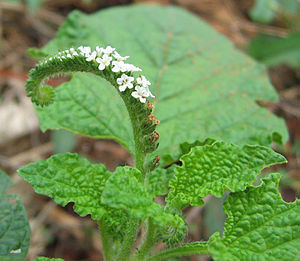Note: This is a project under development. The articles on this wiki are just being initiated and broadly incomplete. You can Help creating new pages.
Heliotropium indicum - Bhurundi
Revision as of 15:39, 30 April 2019 by Arun93 (talk | contribs) (Created page with "thumb|right|''Bhurundi'', ''Heliotropium indicum'' '''Bhurundi''' is an erect, usually much-branched, annual to perennial plant growing up...")
Bhurundi is an erect, usually much-branched, annual to perennial plant growing up to 1.5 metres tall. The stems are usually woody at the base. The plant is often harvested from the wild and used locally for its medicinal virtues.
Contents
- 1 Uses
- 2 Parts Used
- 3 Chemical Composition
- 4 Common names
- 5 Properties
- 6 Habit
- 7 Identification
- 8 List of Ayurvedic medicine in which the herb is used
- 9 Where to get the saplings
- 10 Mode of Propagation
- 11 How to plant/cultivate
- 12 Commonly seen growing in areas
- 13 Photo Gallery
- 14 References
- 15 External Links
Uses
Wound healing, Skin diseases, Insect bites, Fever, Eye pain [1]
Parts Used
Chemical Composition
Common names
| Language | Common name |
|---|---|
| Kannada | bhoorundi, celubaladagidha, chaelu baalada gida, chaelu mani, chaelubaala |
| Hindi | hatta-juri, hatisura |
| Malayalam | tekkata, tekkita, teliyenni, telkata |
| Tamil | aanaikundrimani, anai kundumani |
| Telugu | kodikki, naga danti |
| Marathi | NA |
| Gujarathi | NA |
| Punjabi | NA |
| Kashmiri | NA |
| Sanskrit | bhurundi, duralabha, hastishundi, srihastini, suryavarta, vrscikali, nagadanti |
| English | Indian heliotrope |
Properties
Reference: Dravya - Substance, Rasa - Taste, Guna - Qualities, Veerya - Potency, Vipaka - Post-digesion effect, Karma - Pharmacological activity, Prabhava - Therepeutics.
Dravya
Rasa
Tikta (Bitter), kashaya (Astringent)
Guna
Laghu (Light), Snigdha (Oily)
Veerya
Ushna (Hot)
Vipaka
Karma
Pitta, Vata
Prabhava
Habit
Identification
Leaf
| Kind | Shape | Feature |
|---|---|---|
| Simple | Opposite | Leaves simple, opposite, 11 x 6 cm, sub-deltoid or broadly ovate, apex acute,base turncate, margin undulate, chartaceous; petiole 3-6 cm long |
Flower
| Type | Size | Color and composition | Stamen | More information |
|---|---|---|---|---|
| Bisexual | Curved spikes | Violet or pink | 5 | Flowers sessile, in terminal or leaf-opposed curved, to 20 cm long spikes. Calyx- lobes 5, 1.5-2 mm long, linear, acute. Corolla pale violet or pink, salver-form; tube 3-4 mm long, slightly constricted distally, 5 -lobed; lobes c. 1 mm long, ovate. Stamens 5, subsessile, free. Ovary weakly 4 -lobed; stigma conical. |
Fruit
| Type | Size | Mass | Appearance | Seeds | More information |
|---|---|---|---|---|---|
| Nutlet | 2 - 3 mm | Nutlets connate in pairs, separating later, ribbed | {{{6}}} |
Other features
List of Ayurvedic medicine in which the herb is used
Where to get the saplings
Mode of Propagation
How to plant/cultivate
Season to grow
Soil type
Propagation
Commonly seen growing in areas
Tropical area, Sub tropical area
Photo Gallery
References
External Links
Categories:
- Ayurvedic Herbs known to be helpful to treat Wound healing
- Ayurvedic Herbs known to be helpful to treat Skin diseases
- Ayurvedic Herbs known to be helpful to treat Insect bites
- Ayurvedic Herbs known to be helpful to treat Fever
- Ayurvedic Herbs known to be helpful to treat Eye pain
- Herbs with Whole plant used in medicine
- Herbs with common name in Kannada
- Herbs with common name in Hindi
- Herbs with common name in Malayalam
- Herbs with common name in Tamil
- Herbs with common name in Telugu
- Herbs with common name in Sanskrit
- Herbs with common name in English
- Habit - Herb
- Index of Plants which can be propagated by Seeds
- Index of Plants which can be propagated by Cuttings
- Herbs that are commonly seen in the region of Tropical area
- Herbs that are commonly seen in the region of Sub tropical area
- Herbs
- Herb






